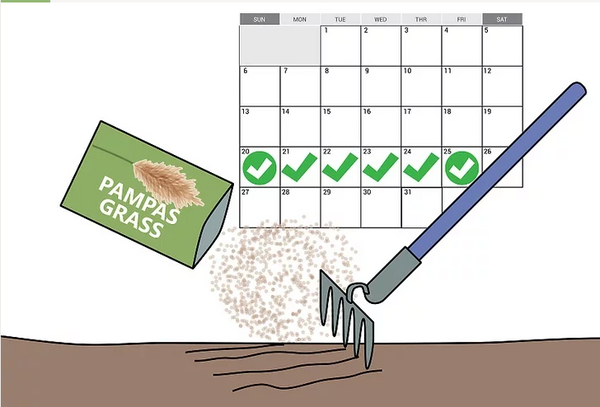
Features:
- ❀ Where winter hardy, this is a large ornamental grass for large landscapes. Excellent specimen. Background plant for borders. Screen. Plumes may be cut and dried for use in indoor flower arrangements.
- ❀ Pampas Grass is hardy to USDA Zones 5-11 where it is best grown in dry to medium moisture, well-drained soils in full sun. Tolerates light shade. Tolerates drought once established. Cut foliage back to the ground in late winter. Clumps may be divided in late winter to early spring. This grass is technically gynodioecious, but usually appears dioecious.
- ❀ Pampas grass is a late-flowering beauty. It adds colour and form to the garden from September until February, with its striking feathery plumes held high above a dense clump of foliage.
- ❀ The only maintenance job on Pampas Grass is cutting back the flowering stems and old foliage in spring. Traditionally, gardeners set fire to the plant - simulating what might happen naturally on the pampas - but this is not advisable, not least because you're likely to kill all manner of over-wintering wildlife. Instead, use loppers and secateurs.
- ❀ Mature reeds can be dried into ornaments like huge feathers.
Specification :
Germination time : 5-7 days
Germination temperature : 15-20 Celsius
Color : Pink, Yellow, Purple
Applications : Farm, balcony, roof, garden, patio, garden, potted
Soil Type: Sandy Loam, Loam, Heavy Loam
Package included :
1 x 100Pampas Grass Seeds
Kindly Tip :
1.Reeds are easy to dry and inflammable. When burning, please pay attention to safety and prevent fire.
2.If you want to get rid of reeds, try not to choose the way of burning, because sometimes small animals hide in the flowers.
How to Grow Pampas Grass Seeds?
Pink pampas grass seeds require loose, well-drained, moist soil for germination. Plant the seeds indoors four to six weeks before the last killing frost in spring. Keep the plants indoors during the first winter to protect young plants from frost if seeds are planted later than spring.

[1]Plant pampas grass in spring. Your grass will need lots of sun, and only a small amount of water, so planting in fall or winter months could hinder your grass’s growth.
Because pampas grass grows so large, it grows better outside in the lawn or garden, rather than in containers. Due to its size and also the sharpness of its leaves, it does not make a good indoor plant.

- This grass can grow to be over 10 ft (3 m) tall. It makes for an excellent natural fence.
- Do not place pampas grass near roadways or driveways; the tall and bushy grass can interfere with lines of sight.
- The plant should also not be placed too close to central air conditioning units as the long leaves can become caught in the fans.
- Pampas grass leaves have sharp edges, so avoid planting in an area where young children play.


How to Care Your Pampas Grass?
1.Water sparingly. Pampas grass can thrive in many conditions, and will adapt to its location. You need only water the ornamental grass once every couple of weeks for the first year of growth. Water more frequently during periods of extreme drought. No watering is needed after the plant is well established.
2.Fertilize the grass. During the first year, fertilize up to three times. After the first year, fertilize only once per year. Use a high-quality garden fertilizer to enhance the beauty of the flowers.It may take up to three years for your pampas grass to flower.
3.Prune established pampas grass. Use trimmers to prune your grass in the late winter or early spring months. You can also tie a piece of rope around the plant, about 4ft (1.2 m) from the ground and use a power weed trimmer to cut the grass. Remove all the foliage and flower stalks above 12 in (30 cm) in height.
- Be careful and wear long sleeves and gloves when pruning and handling your pampas grass plants as the edges are sharp.
- Cut through the clumps after pruning to divide them. The sliced clump can then be planted elsewhere.
4.Drain the leaves. Tie the leaves of the grass together with string in November to allow water to drain from the plant. This will prevent shock during the cold months.
.png?w=683&h=235)










